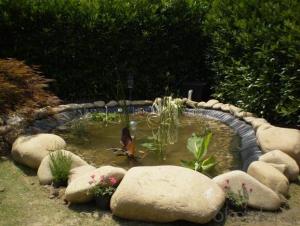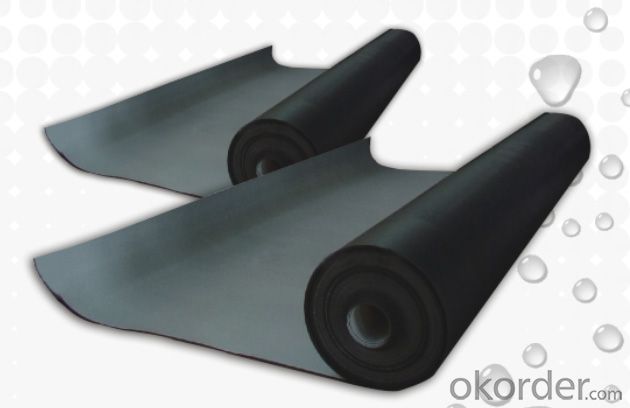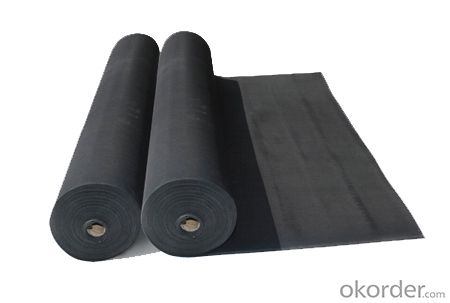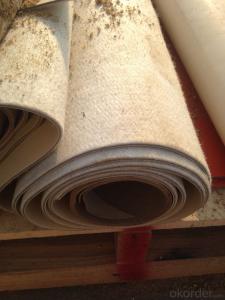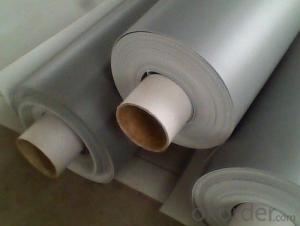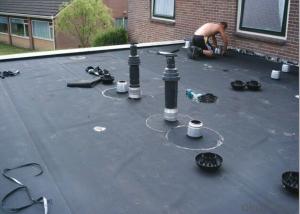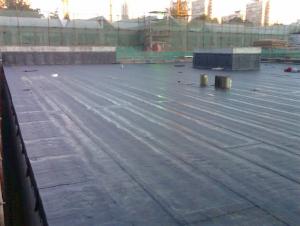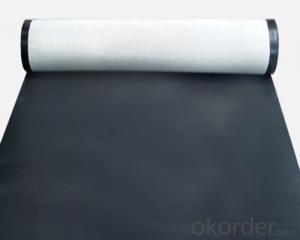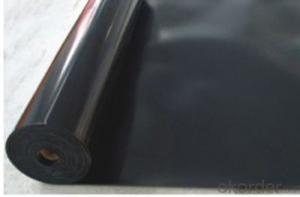EPDM Rubber Material Waterproof Membrane for Roof
- Loading Port:
- Shanghai
- Payment Terms:
- TT OR LC
- Min Order Qty:
- 50000 m²
- Supply Capability:
- 5000000 m²/month
OKorder Service Pledge
OKorder Financial Service
You Might Also Like
EPDM Rubber Material Waterproof Membrane for Roof
Description Of EPDM Rubber Material Waterproof Membrane for Roof:
This waterproof coiled material is of high elasticity with best performance among high polumer waterproof coiled material in the world.It is also the most typical one in the world.Waterproof coiled material made of ternary ethylene-propylene rubber is produced with the use of the most advanced contiuous extrusion and vulcanization technology and related equipments which are specially designed for production of such product.It is good in compactness,without bubble and performance difference in length and breadth,perfomances reach or exceed the demands of GB18173.1-2000 standard.
Main Features of EPDM Rubber Material Waterproof Membrane for Roof:
1.EPDM waterproof membrane for bridge engineering waterproof
2.EPDM waterproof membrane for water conservancy projects ,such as river bank,lake dam seepage.
3.EPDM waterproof membrane for the municipal engineering.
4.EPDM waterproof membrane for aquaculture.
Specifications of EPDM Rubber Material Waterproof Membrane for Roof:
| Number | Item | Unit | Value | |
| 1 | Size Variation | Thichness | % | ±10 |
| Width | % | ±1 | ||
| Length | % | Allowed negative | ||
| 2 | Breaking tensile strength at normal temperature | Mpa | ≥7.5 | |
| Breaking tensile strength at 70°C | Mpa | ≥2.3 | ||
| 3 | Breaking elongation at normal temperature | % | ≥450 | |
| Breaking elongation at -20°C | % | ≥200 | ||
| 4 | Tear strength | KN/m | ≥25 | |
| 5 | Impermeability(30min) | * | 0.3Mpa no leakage | |
| 6 | Bending at low tempreture | °C | ≤-40 | |
| 7 | Stretch tensor at heating | Elongate | mm | ≤2 |
| Shrink | mm | ≤4 | ||
| 8 | Air oven aging(80°C×168h) | Tensile strength at break retained | % | ≥80 |
| Elongation at break retained | % | ≥70 | ||
| 9 | Anti-alkali | Tensile strength at break retained | % | ≥80 |
| Elongation at break retained | % | ≥80 | ||
| 10 | Nuture weathing at manual simulation | Tensile strength at break retained | % | ≥80 |
| Elongation at break retained | % | ≥70 | ||
Applications of EPDM Rubber Material Waterproof Membrane for Roof:
Widely used in roofs, basement, toilet ,swimming pool, and all kinds of industry and civil building waterproofing, reservoir, vivicism, bridge, underground, tunnel and dam waterproofing ,especially to the keystone waterproofing projects which is durability, high corrosion resistance and easy deformation.



IMages of EPDM Rubber Material Waterproof Membrane for Roof:




FAQ of EPDM Rubber Material Waterproof Membrane for Roof:
1. What are we supplying?
We are specialized in producing Colorful Asphalt Roof Shingle, SBS/APP modified bitumen waterproof membrane, Self adhesive bitumen waterproof membrane, PVC waterproofing membrane, EPDM rubber roofing membrane, Single Component Polyurethane Waterproof Coating, and Spray Polyurea Waterproof Coating
.
2. How Many years experience do we have?
We have been exported to more than 20 countries in the past 15 years.
3. How long do we usually reply your request?
We always reply our customer within 24 hours.
- Q: Can a waterproofing membrane be used for swimming pool decks?
- Yes, a waterproofing membrane can be used for swimming pool decks. A waterproofing membrane is a protective barrier that prevents water from seeping into the underlying structure. It is commonly used in areas where water exposure is high, such as swimming pool decks, to ensure the longevity and durability of the structure. The membrane is typically applied over the concrete surface of the pool deck and provides a seamless, watertight seal. This helps to prevent water damage, such as cracking, spalling, or deterioration of the concrete, and minimizes the risk of leaks or water seepage into the surrounding areas. Additionally, a waterproofing membrane can also provide added benefits such as slip resistance, UV resistance, and protection against chemicals and stains. It is important to choose a high-quality waterproofing membrane that is specifically designed for swimming pool decks and can withstand frequent exposure to water and other environmental factors.
- Q: Can a waterproofing membrane be used in areas with extreme weather conditions, such as hurricanes or snowstorms?
- Areas with extreme weather conditions, such as hurricanes or snowstorms, can benefit from the use of a waterproofing membrane. These membranes are designed to create a protective barrier against water infiltration and can withstand various weather conditions effectively. They are made from moisture-resistant materials and can be installed in roofs, basements, or foundations. In regions prone to hurricanes, waterproofing membranes play a crucial role in preventing water damage. They create a barrier that keeps water out, even during heavy rainfall or storm surges. These membranes are often reinforced and possess high tensile strength to withstand the strong winds and pressure associated with hurricanes. Similarly, in areas experiencing heavy snowstorms, waterproofing membranes are valuable in preventing water intrusion caused by melting snow or ice dams. They are designed to be flexible and resistant to extreme temperatures, ensuring their integrity and leak prevention in freezing conditions. However, it is essential to select the appropriate type of waterproofing membrane for the specific weather conditions in the area. Different membranes offer varying levels of resistance to extreme weather, so consulting with a professional is advisable to determine the most suitable membrane for the climate and weather patterns. Additionally, proper installation and regular maintenance are crucial to ensure the longevity and effectiveness of the waterproofing system in extreme weather conditions.
- Q: Can a waterproofing membrane be used on plywood surfaces?
- Yes, a waterproofing membrane can be used on plywood surfaces. Plywood is a commonly used material for construction, including outdoor projects such as decks and balconies. However, plywood is not naturally waterproof and can be susceptible to moisture damage over time. To protect plywood surfaces from water damage, a waterproofing membrane can be applied. This membrane acts as a barrier, preventing water from seeping into the plywood and causing rot or decay. There are various types of waterproofing membranes available, including liquid-applied membranes, sheet membranes, and peel-and-stick membranes. These membranes are designed to adhere to the surface of the plywood and create a watertight seal. It is important to follow the manufacturer's instructions for proper application and ensure that the plywood surface is clean and dry before applying the membrane. By using a waterproofing membrane, plywood surfaces can be effectively protected from water damage, extending their lifespan and maintaining their structural integrity.
- Q: How long does a waterproofing membrane typically last?
- A waterproofing membrane typically lasts between 10 and 20 years, depending on the quality of the product, installation method, and environmental factors.
- Q: Can a waterproofing membrane be applied to uneven surfaces?
- Indeed, it is possible to apply a waterproofing membrane to surfaces that are not perfectly even. However, the degree of success and effectiveness achieved may vary depending on the extent of the unevenness. To ensure optimal results, it is crucial to adequately prepare the surface by eliminating any loose debris, addressing significant gaps or holes, and smoothing out any elevated points or ridges. Additionally, certain types of waterproofing membranes possess superior flexibility and are more adept at adapting to uneven surfaces compared to others. Therefore, it is highly advisable to seek guidance from a professional waterproofing contractor who can evaluate the surface condition and recommend the most suitable waterproofing membrane tailored to the specific unevenness.
- Q: Can a waterproofing membrane be used for seawalls or bulkheads?
- Yes, a waterproofing membrane can be used for seawalls or bulkheads. These membranes are designed to provide a barrier against water penetration and can effectively protect structures from the corrosive effects of saltwater and wave action. This makes them suitable for use in constructing and maintaining seawalls and bulkheads, ensuring their durability and longevity.
- Q: What is the difference between construction non-vulcanized waterproofing membrane and vulcanized waterproofing membrane?
- Non-vulcanized rubber waterproofing membrane: from SR or SR and asphalt blends by mixing, rolling made of coil, without vulcanization can use the product. The bonding between the coils and their bonding properties with the mortar is good, the manufacturing is convenient, the price is low, but the tensile strength is low. Can be divided into two types of rubber and rubber asphalt. Rubber type commonly used SBR and other SR production. Generally used for civil construction roof waterproof.
- Q: Can a waterproofing membrane be used in conjunction with green building practices?
- Certainly, a waterproofing membrane can be utilized alongside green building practices. In actuality, integrating a waterproofing membrane into the construction of a green building can greatly enhance its overall sustainability and efficiency. One of the fundamental principles of green building practices is to maximize energy efficiency and decrease the environmental impact of a structure. By installing a waterproofing membrane, the building's outer covering can be shielded from moisture intrusion, thereby preventing water damage and potential mold growth. This, in turn, aids in preserving the structural integrity of the building, reducing the necessity for costly repairs and replacements, which can consume resources and generate waste. Moreover, a waterproofing membrane can contribute to improved indoor air quality. By preventing water infiltration, it assists in creating a dry and healthy living or working environment, minimizing the risk of respiratory problems and other health issues associated with dampness. Furthermore, a waterproofing membrane can enhance the energy efficiency of a building. By preventing water from seeping into the walls or foundation, it lessens the potential for heat loss through moisture evaporation, thus reducing the energy required for heating and cooling. This can lead to decreased energy consumption and lower carbon emissions, aligning with the objectives of green building practices. However, it is crucial to select a waterproofing membrane that is environmentally friendly and compliant with green building standards. Seek out membranes that are crafted from recycled or sustainable materials and possess low VOC (volatile organic compound) content. Additionally, consider opting for a membrane that is designed for longevity and durability, as this can further minimize the environmental impact by reducing the need for replacement over time. In conclusion, a waterproofing membrane can be an invaluable addition to any green building endeavor. It serves to safeguard the building envelope, enhance indoor air quality, and improve energy efficiency. By choosing an environmentally friendly membrane, the overall sustainability of the building can be further enhanced.
- Q: Can a waterproofing membrane be used on bridge decks?
- Yes, a waterproofing membrane can be used on bridge decks. Bridge decks are exposed to various weather conditions, including rain, snow, and ice, which can cause damage over time. Applying a waterproofing membrane on bridge decks can help to protect the concrete from moisture penetration, preventing deterioration and extending the lifespan of the bridge. Additionally, the waterproofing membrane serves as a barrier against chloride ions, which can accelerate the corrosion of reinforcing steel in the bridge deck. Therefore, using a waterproofing membrane on bridge decks is a common practice in bridge construction and maintenance to ensure their durability and longevity.
- Q: Is a waterproofing membrane compatible with different types of roofing materials?
- Yes, a waterproofing membrane is compatible with different types of roofing materials. It can be used with various roofing systems such as asphalt shingles, metal, concrete, or tile roofs. The purpose of a waterproofing membrane is to create a barrier against moisture, regardless of the roofing material used.
Send your message to us
EPDM Rubber Material Waterproof Membrane for Roof
- Loading Port:
- Shanghai
- Payment Terms:
- TT OR LC
- Min Order Qty:
- 50000 m²
- Supply Capability:
- 5000000 m²/month
OKorder Service Pledge
OKorder Financial Service
Similar products
Hot products
Hot Searches
Related keywords
